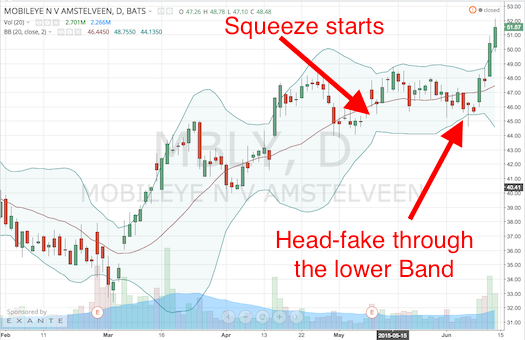Blog Posts Tagged with Bollinger Bands
How Bollinger Bands (and Stochastic) Helped Navigate the Market in 2018
I meant to write this over the weekend when I was going through charts and noticed how the S&P 500 has been bouncing between its upper and lower Bollinger Bands since February. So here's the chart, which I've annotated to identify some key turning points (you can click the chart to get a larger version):
Read More ➞Using the Bollinger Band Squeeze Scans
This will cover how to make use of all the Bollinger Band Squeeze-related scans, including:
- Bollinger Band Squeeze Stock Screen
- Bollinger Band Squeeze Started
- Bollinger Band Squeeze Ended
- Bollinger Band Squeeze + Lower Band Touch
- Bollinger Band Squeeze + Upper Band Touch
As you may be able to tell by the names, the last four scans are subsets of the first -- the plain old Bollinger Band Squeeze Scan. So those other four scans will have shorter lists of stocks. We'll see why you might want to use one of those scans instead of the primary BB Squeeze scan.
Read More ➞New Stock Scans: Upper & Lower Bollinger Band Touches
Here are two new scans I released the other day:
These should be useful to combine with other scans when using the Combination Scan.
Read More ➞This is Why I Track Bollinger Band Squeezes (MBLY)
I often talk about how I like to use Bollinger Bands to catch range contraction-to-expansion moves. Just last week Mobileye made a nice move after being in a Bollinger Band Squeeze for a very short time. You can see on MBLY's recent events page that a Squeeze started on May 8th. As I've written before, John Bollinger has noted that you'll often see stocks in a squeeze tag one band and then reverse and shoot through the opposite band:
Traders beware! There is a trick to The Squeeze, an odd turning of the wheel that you need to be aware of, the head fake. Often as the end of a Squeeze nears, price will stage a short fake-out move, and then abruptly turn and surge in the direction of the emerging trend...
So MBLY had all the ingredients to do exactly what Mr. Bollinger laid out. MBLY's trend table page shows that it was trending up and then went trendless (according to ADX & Directional Movement) once the Squeeze began. Then it crossed the lower band and reversed to close back above the lower band and proceeded to launch above the upper band. That was such a strong move that it's now walking up the upper band, which is another classic thing that Mr. Bollinger has written about.

This is why I built the Bollinger Band alerts / scans into the site. I'm always checking the "Bollinger Band Squeeze Started", "Squeeze Plus Upper Band Touch" and "Squeeze Plus Lower Band Touch" scans for trading candidates.
Read More ➞Trading the VIX using Bollinger Bands
Back in October, while at Stocktoberfest, I attended a talk by Chris Kimble of Kimble Charting Solutions titled "How to Capitalize on the Technimentals" It was about "how investors can benefit from combining the power of the pattern along with sentiment and fundamentals." As part of that discussion Chris covered a trade he had recently initiated. He got long XIV, the inverse VIX ETN during the mid-October selloff. (He now has a follow-up blog post showing how the trade played out -- looks like he made about a %40 profit in less than 4 weeks). I was really impressed with that strategy, which was basically a bet that volatility would return to its recent norm (mean reversion).
Since then I've been watching the VIX and XIV closely, waiting for a chance to put on a similar trade. As you know, volatility has been spiking of late largely thanks to the slide in the price of oil. So I've been studying the charts of the volatility instruments this week and I noticed something really interesting -- it seems that there are pretty good signals to not only short volatility but also to get long it. If you've spent any time at all on this site you'll notice a lot of mentions of Bollinger Bands and NR7 bars / candles. I use both of those to capitalize on the fact that low volatility begets high volatility (and high begets low). In other words, I'm always on the lookout for prices to swing from periods of range contraction to range expansion.
Read More ➞Popular Now
Recent Comments
- TraderMike on BOOT
- Dr_Duru on BOOT
- TraderMike on Stochastic Reached Oversold
- SuccessfulGrasshopper897 on Stochastic Reached Oversold
- Cos3 on Adding float as advanced filter criteria?
From the Blog
Blog Tags
Featured Articles